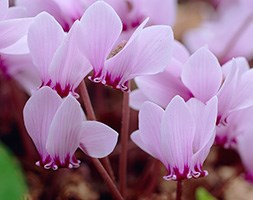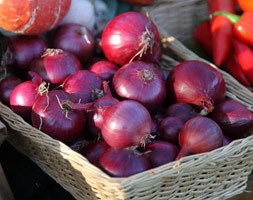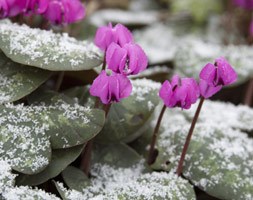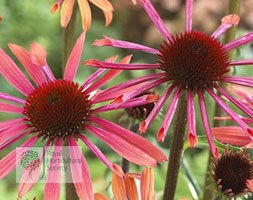Price reductions at Crocus
by Sarah - December 26th, 2013.Filed under: Crocus, Price Reductions.
Crocus has cut the price of these items
Cyclamen hederifolium (cyclamen bulb (syn. Neapolitanum)) was £2.99 now £0.99
Position: full sun to partial shade Soil: humus-rich, well-drained soil Rate of growth: average Flowering period: October to November Hardiness: fully hardy bulb size: 13/15 With their pretty, marbled, heart-shaped leaves and upright, fragrant pink or white flowers, these easy to grow cyclamen have a long season of interest before disappearing below ground over the summer. The flowers of this autumn-flowering cyclamen often appear well before the leaves, which form a pretty carpet after the flowers have finished. Although they are usually planted in shade, these cyclamen originate from the Mediterranean, so are equally happy in sun. Plant them en masse in a woodland setting with ferns and other shade-tolerant plants or around the base of deciduous trees. Garden care: Plant tubers with the rounded usually smooth side down, shallowly in humus-rich, fertile soil. Apply a mulch of well-rotted leafmould around the crown of the plants in spring as the foliage starts to die back.
onion ‘Red Baron’ (onion sets) was £2.99 now £1.79
Position: full sun Soil: any soil Rate of growth: average Other features: each pack includes growing instructions and recipes Hardiness: fully hardy A mid-late maturing variety with flattish-round bulbs of a beautiful dark red colour. An excellent cropper producing attractive, firm well flavoured bulbs which keep well. An attractive addition in the salad bowl. Garden care: Plant onion sets from mid-February to March, 15cm (6in) apart in rows 30cm (12in) apart. Lift the onions when they are mature (normally in August) and allow them to dry before using.
Cyclamen hederifolium (cyclamen bulb (syn. Neapolitanum)) was £6.99 now £2.97
Position: full sun to partial shade Soil: humus-rich, well-drained soil Rate of growth: average Flowering period: October to November Hardiness: fully hardy bulb size: 13/15 With their pretty, marbled, heart-shaped leaves and upright, fragrant pink or white flowers, these cyclamen have a long season of interest before disappearing below ground over the summer. The flowers of this autumn-flowering cyclamen often appear well before the leaves, which form a pretty carpet after the flowers have finished. Although they are usually planted in shade, these cyclamen originate from the Mediterranean, so are equally happy in sun. Plant them en masse in a woodland setting with ferns and other shade-tolerant plants or around the base of deciduous trees. Garden care: Plant tubers rounded (usually smooth) side down, side down, shallowly in humus-rich, fertile soil. Apply a mulch of well-rotted leafmould around the crown of the plants in spring as the foliage starts to die back.
Cyclamen coum (sow bread) was £6.99 now £3.49
Position: partial shade Soil: moderately-fertile, humus-rich, well-drained soil Rate of growth: average Flowering period: December to March Flower colour: pink Hardiness: fully hardy Bulb size: 13/15 Delicate pink flowers with upswept petals appear in winter or early spring above rounded, silvery-green leaves. These diminutive cyclamen are perfect for naturalising around the base of deciduous trees and shrubs. Best in humus-rich, well-drained soil in partial shade, they make excellent companions for ferns and other shade-loving plants. Garden care: Plant tubers with the rounded (usually smooth) side down, shallowly in humus-rich, fertile soil. Apply a generous 5-7cm (2-3in) mulch of well- rotted leaf mould around the crown of the plants in spring as the foliage starts to die back.
Echinacea ‘Sunset’ (PBR) (Big Sky Series) (coneflower) was £8.99 now £6.99
Position: full sun Soil: most soils, except very dry or boggy Rate of growth: average Flowering period: June to September Hardiness: fully hardy Overlapping, bright orange ray florets surround a prominent orange-brown cone, create vibrantly coloured flower heads, which appear in large numbers from midsummer to mid-autumn on stiffly upright stems. Like other coneflowers, it is long-flowering and will cope well with adverse we ather conditions, except drought. Try it dotted through a sunny, mixed border or in bold drifts among grasses where it will extend the season of interest. It is attractive to bees and butterflies, and birds will flock to the seedheads. Garden care: Lift and divide congested colonies in autumn or spring. In autumn cut back all dead flower stems to the ground. Coneflower s benefit from a spring or autumn mulch with well-rotted compost.










